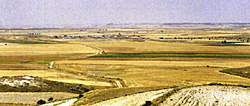 The first major engagement of the Peninsula War kicks off this feature. The weather, with higher than unusual rainfall followed by a hot, dry period, is identical to that of July 1808.
The first major engagement of the Peninsula War kicks off this feature. The weather, with higher than unusual rainfall followed by a hot, dry period, is identical to that of July 1808.
At right: road from Palacios showing probable French artillery position.
Marshal Bessieres had received the news that Gen. Gregorio de la Cuesta had thrown off the defeat which Gen. Merie had inflicted at Cabezon and was busily recruiting. Bessieres knew he could not wait long before dealing with the threat. Vague rumors reached him that a Galician army was forming in that province, but it was not significant in terms of any immediate threat - at least in the minds of the French generals. Cuesta's recruiting was taking place in the region around Valladolid and surrounding areas of Castille.
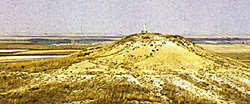 Bessieres gathered together as much of his army as could be spared from their duties of putting down the revolt of the Biscayan provinces and these men were to be joined by some reinforcements from France. After subduing Santander, General Lefebvre Desnouettes was to move on to take Zaragoza whilst Bessieres set out to attack Cuesta.
Bessieres gathered together as much of his army as could be spared from their duties of putting down the revolt of the Biscayan provinces and these men were to be joined by some reinforcements from France. After subduing Santander, General Lefebvre Desnouettes was to move on to take Zaragoza whilst Bessieres set out to attack Cuesta.
The story of Medina de Rioseco as told by Oman [5]
holds that Bessieres advanced from Palencia, rather than Valladolid which brought his men to Palacios on a different road from that anticipated by the Spanish. This is in concert with the most recent Spanish research [6] but there, the stories part company. Oman has Blake and Cuesta taking up weird defensive positions, not hastily but
deliberately, supposedly as a result of incompetence (on Cuesta's part, as superior general) or a desire to see a rival discomfited should a defeat ensue. The current research logically shows that Cuesta and Blake were marching on separate paths seeking intelligence of the French in the wrong direction and were forced to assume poor defensive postures having been overtaken by events. This seems to me a far more reasonable proposition than that a general - even one
as old and crotchety as Cuesta - would jeopardise his command and that of a colleague by dispositions that even a novice wargamer would hesitate to adopt for his metal troops! So, I lean towards the view that Bessieres fooled the Spanish and forced them into hasty decisions by
marching from Palencia while the Spanish were moving toward his anticipated presence at Valladolid.
Blake had left one of the divisions of his army to defend the passage into Galicia
and another in Benavente to support a possible withdrawal. On the 13th the
march continued, with the vanguard and the other two divisions, and reached
Villanubla, south of Palacio and towards Valladolid, in search of the French main
body without finding any trace of them. Blake's idea was that the French advance
would be from Valladolid - through the plains of the Mudarra - and this obsessed
the Spanish generals who were convinced of the fact that such would be, due to the
abundant parties of French cavalry detected in that locality.
But he was mistaken: "We were absolutely ignorant of the situation of the French in all the Peninsula [7] recalls Blake. Since Galicia was not directly
threatened and Blake had sufficient troops to defend incursions, he did not have to
take risks such as seeking-out the French; but he was in the same position as
Cuesta, they were forced because of the political situation of the moment: inaction
would be seen as treason.
At break of day on the 13th, Spanish cavalry patrols were sent in all directions
on all the possible routes by which the imperial army could appear, to obtain
news of their location, but without success. The French, meanwhile, knew
where the Spanish were to be found. At two o'clock on the moming, of the 14th,
Bessieres' Army was under way from Tordehumos. Immediately after, the light
cavalry of General Lasalle vacated Palacio, near Medina de Rioseco, to one of the
Spanish cavalry detachments (200 sabres est.).
At last, information about the French. Most of the French advance patrol was
made prisoner. Blake gave orders: vanguard, 1st and 4th divisions to cover the highway from Valladolid. The confused and tired troops were sent back towards Rioseco in the darkness. They deployed on the heights above the carriage road in the dark, exhausted by marches and counter
marches.
Blake deployed the Vanguard and 1st division in high ground on Paramo de Valdecuevas in a somewhat confused manner. Cueta was in the vicinity of Medina de Rioseco and might well have not learned of the imminent arrival of French forces (on a surprise flank march).
The battle is described quite differently by Oman and Spanish researchers, one of
whom accompanied me on my visit to Rioseco. I must admit that my own views have
changed as a result of my visit. Being previously ignorant of the current Spanish
research, I had largely accepted Oman's version (although in the recent book which
I coauthored with Richard Partridge. [12]
(I had access to the Spanish data and mentioned it. I do not intend to give a
detailed account of the battle here but will point out one or two of the disagreements
between British historians and the Spanish view.)
Oman [13] mentions an "...isolated eminence, the
mound of Monclin..." to the east of the plateau of Valdecuevas and says that
Bessieres "...drew up the greater part of his artillery (twenty guns)..." on this hill.
Having seen the hill with my own eyes, I can say with fair certainty that Oman states [14] that Blake "...was drawn up in a short, compact formation, three lines deep..." with, as shown by Darbishire's accompanying map, the Vanguard in front and slightly, extending the army's left, and only two battalions in the third line. He suggests strongly that this was a planned deployment, not the hasty one indicated by the Spanish sources, who state: "The battalion of Voluntarios de Navarra was covering, in skirmish order, the road Monclin - Palacios.
A second line next to the Eastern edge of the plateau and preceded by skirmishers was formed by the halfbattalions of the Regiments Voluntarlos de Gerona and Voluntarios de Cataluha. The artillery (six pieces) was situated on the flank.
A third line was established by four battalions belonging to the Regiments of Zaragoza, Mallorca, Aragon and half of Barbastro, under the command of the Conde de Maceda, and six more
batallions: one of Provisional Grenadiers, two of del Rey, two of Hibernia and one of the Blandengues de Buenos Aires, which constituted the left-most unit.
Finally, there was located a reserve of four battalions: one of Mallorca; the Provincial Militia of Salamanca; the Provincial Militia of Mondohedo and the Provincial Militia of Tuy, plus six more artillery pieces. One of the flanks was "guarded", more in hope than expectation, by the minute force of one cavalry squadron of Montesa and a half-squadron of Dragones de
la Reina.
Once more, Oman criticises Cuesta for being "...completely occupied by ... [Mouton's] ... trifling show of attack. However, looking, once more, at the terrain itself, Mouton was occupying high ground which dominated Cuesta's position and which, through chest-high vegetation
(I waded through it and got several nasty scratches), would have obscured his actual strength. The Spaniard would have risked the French commander's descending against his flank with substantial cavalry support had he moved towards Blake's position.
Consequently, the "trifling show" which might well have constituted cavalry and infantry manoeuvres in the undulating, weed-choked terrain could have completely confused Cuesta as to Mouton's intentions and strength. The Spanish troops under Cuesta's command were (assuming Blake had agreed to ceding command, over which some uncertainty exists) the Galician 4th division, some raw levies of highly dubious quality and a handful of horsemen. Perhaps one can understand his reluctance to risk a flank attack during a march across ideal cavalry country.
Finally, Lasalle was said, by Oman, to have "...rode into the open space on the left of the Galicians, formed up the 22nd Chasseurs a cheval at right angles to the Spanish line and charged infuriously upon Blake's flank ...... The Spanish researchers have evidence that this was achieved, not by the French cavalry deploying in open space, but doing so hidden by a fold in the ground just below the paramor, riding up a hidden gully and arriving at the canter on Blake's flank. In my visit to Medina, I was lucky enough to have the loan of a horse and,
with three or four friends, found the gully a broad and relatively gentle water course caused by rain flood, all dry in summer - and proved that such a manoeuvre was feasible. I am no
horseman and my mount was a docile farm horse but his more sprightly fellows goaded him to follow their canter (with me hanging on for dear life!) and we arrived at the head of the
gully with the horses relatively fresh and in a position that would have caused total surprise to any body of infantry located where the Buenos Aires regiment were sited.
We all tend to accept historical narratives - particularly those of well-respected writers of many years back -- but it behoves us not to take anything for granted and to re-examine opinions in the light of what we can see with our own eyes before accepting criticisms
of the generalship of past commanders. None of these comments are intended to detract from
the wonderful history which Sir Charles Oman left us, but even he must have relied on things he was not able to check in fine detail and, if we can shed light on his work where we are able, I feel sure he would approve.
[1] These units had made several detachments and were under strength.
More Battle of Medina de Rioseco
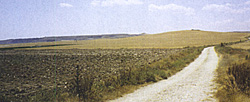 At right: Teson de Moclin from the Palacios Road.
At right: Teson de Moclin from the Palacios Road.
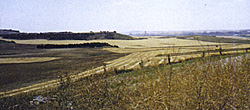 At right: Mouton's position facing Cuesta.
At right: Mouton's position facing Cuesta.
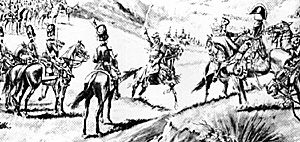 The Battle of Medina del Rio Seco. General Lasalle prepares to lead the squadrons of the guard in a decisive charge.(J Girbal) From 'Le General-Comte Lasalle' by F Hourtoule.
The Battle of Medina del Rio Seco. General Lasalle prepares to lead the squadrons of the guard in a decisive charge.(J Girbal) From 'Le General-Comte Lasalle' by F Hourtoule.
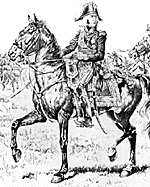 Marshal Bessibres, Duke of Istria (1768-1813). Led II Corps to victory at Medina. (Job)
Marshal Bessibres, Duke of Istria (1768-1813). Led II Corps to victory at Medina. (Job)
FOOTNOTES
[2] The Imperial Guard contained, at this time, 2 regiments each of Fusilier Grenadiers and Fusilier Chasseurs. These regiments each comprised 2 battalions. Each battalion fielded four companies of 120 men giving a potential total of 1920. If one is to believe the strengths given for the Guard Fusiliers at Medina by both British and Spanish sources, it would sem that all four battalions were present and not just three. It is strange to note that Oman, Sir C. - "A History of the Peninsular War", Vol I p614 (Greenhill Books) shows two Guard Fusilier regiments present under Dorsenne in Spain as having 3 battalions each - this was not the proper complement and must be suspect.
[3] Oman, op. cit. Vol I p167 footnote, does not give the unit but, in a painting by J. Girbal in "Le General Comte de Lasalle" by F. G. Hartoule, reproduced in "Napoleon's War in Spain (Lachouque, Tranie & Carmigniani, Pub. Arms &
Armour Press 1982), the artist depicts the Gendarmes being prepared for their charge against the Galician 4th Div. We have thus opted to identify them as the guard cavalry concerned. The strength given by Oman in his orbat for the Garde when first entering Spain is 304, which fits with the Rioseco strength he gives.
[4] Oman says (op cit. Vol I p169) that the French commander ranged the "...greater part of his artillery (20 guns)..." against Blake on the Teson de Monclin. Certainly the French outnumbered the Spanish in artillery and Oman says that Blake had "...no more than 30 guns..." Interestingly, when the French captured Blake's artillery, they reportedly seized "The 10 guns of Blake's wing..." (Oman p171) - suggesting this was Blake's full complement; there are reasons for doubting this. Vela, F. M. et al. - "La Batalla cle Medina de Rioseco, 1808" (Researching & Dragona - January 1996 pp27-47) a Military research Journal published in Spain (hereafter R & D) show the French infantry divisions as taking their divisional batteries with them in the outflanking manoeuvres. It should be noted that we have not been able to examine the source material used by R & D so are unable to vouch for the data but the authors are prominent Spanish military researchers and include military personnel.
[5] Oman - op cit. Vol I p. 166 et seq.
[6] "La Batalla del Monclin" - Camino, Sahudo, Stampa, Vela & Sanchez (Iltre. Ayuntamlento de Medina de Rioseco)
[7] "Diario de Operaciones" - Ten. Gen. Blake, J.
[8] We have used the term "uniclades" meaning "united" to indicate that these are the combined grenadier companies of four line regiments: Zaragoza, Mallorca, Aragon and Vol. cle la Corona. R & D do not indicate where the parent regiment of the last named unit was located.
[9] R & D show this as an infantry regiment but that is a printer's error - the line cavalry unit was present.
[10] The combined grenadier companies of four line regiments: Toledo, Navarra, Sevilla and Napoles. R & D do not indicate where the parent regiments of the two last named units were located.
[11] This goes some way to resolving the riddle concerning distribution of artillery. There were, apparently 20 guns, 15 with Blake and 5 with Cuesta under Portago's control.
[12] "Battle Studies in the Peninsula" p. 24 et seq. - Partridge & Oliver (Constable)
[13] op. cit.
[14] op. cit. p. 169
Battle of Medina de Rioseco: Introduction
Battle of Medina de Rioseco: Orders of Battle
Battle of Medina de Rioseco: Map (large: 99K)
Battle of Medina de Rioseco: Map (Jumbo: extremely slow: 631K)
Back to Battlefields Vol. 1 Issue 7 Table of Contents
Back to Battlefields List of Issues
Back to Master Magazine List
© Copyright 1999 by Partizan Press.
This article appears in MagWeb (Magazine Web) on the Internet World Wide Web.
Other military history articles and gaming articles are available at http://www.magweb.com